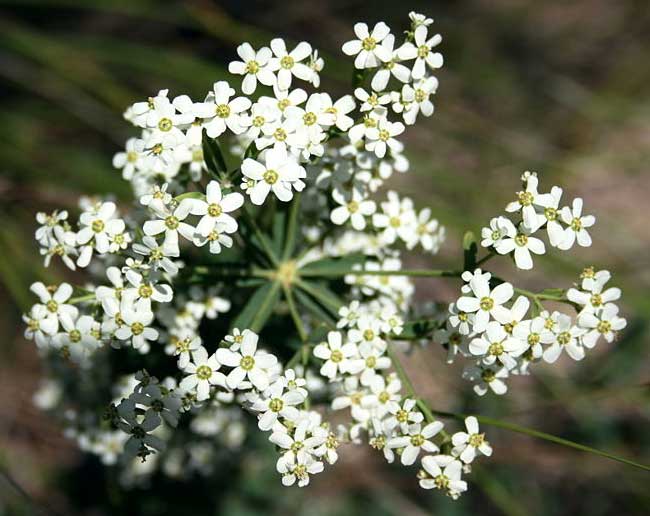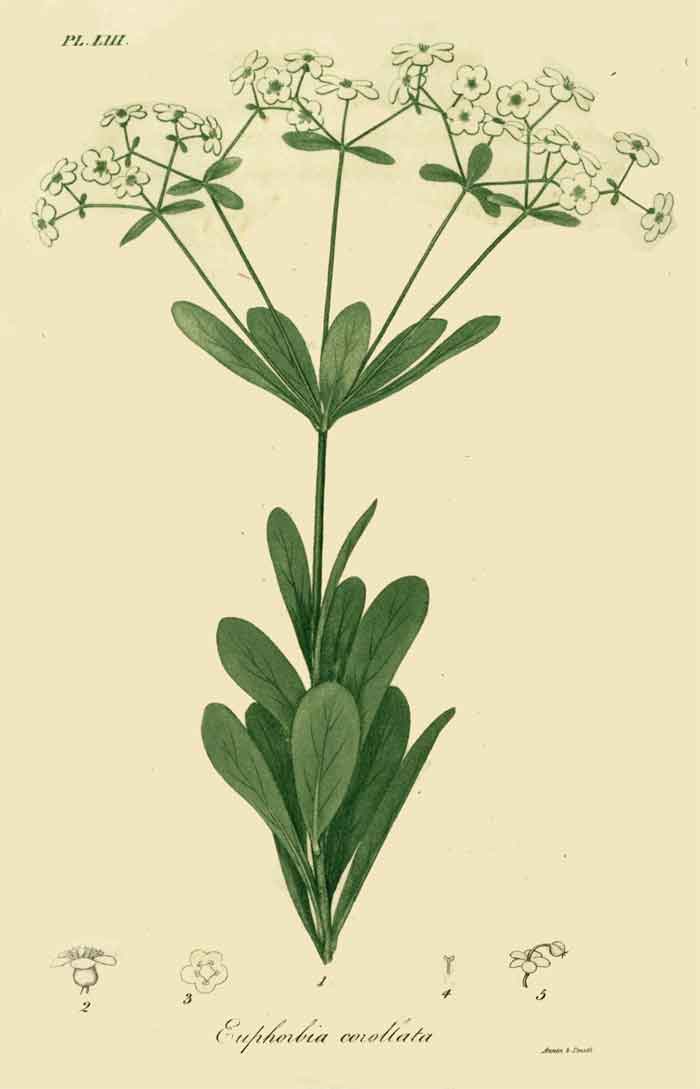
Euphorbia corollata (Photo: Cody Hough)
Classification System: APG IV
Superregnum: Eukaryota
Regnum: Plantae
Cladus: Angiosperms
Cladus: Eudicots
Cladus: Core eudicots
Cladus: Rosids
Cladus: Eurosids I
Ordo: Malpighiales
Familia: Euphorbiaceae
Subfamilia: Euphorbioideae
Tribus: Euphorbieae
Subtribus: Euphorbiinae
Genus: Euphorbia
Subgenus: E. subg. Chamaesyce
Sectio: E. sect. Alectoroctonum
Species: Euphorbia corollata
Name
Euphorbia corollata L., Sp. Pl. 1: 459. 1753.
Synonyms
Homotypic
Galarhoeus corollatus (L.) Haw., Syn. Pl. Succ.: 146. 1812.
Agaloma corollata (L.) Raf., Fl. Tellur. 4: 117. 1838.
Tithymalopsis corollata (L.) Klotzsch & Garcke, Monatsber. Königl. Preuss. Akad. Wiss. Berlin 1859: 249. 1859.
Tithymalopsis corollata (L.) Small, Fl. S.E. U.S.: 717. 1903, comb. superfl.
Heterotypic
Euphorbia corollata var. hirsuta Macnab, Edinburgh New Philos. J. 19: 63. 1835.
Euphorbia discolor Bertol., Misc. Bot. 10: 37. 1851, nom. illeg.
Euphorbia corollata var. grandiflora Boiss. in A.P.de, Prodr. 15(2): 67. 1862.
Euphorbia corollata var. subpetiolata Boiss. in A.P.de, Prodr. 15(2): 67. 1862.
Euphorbia corollata var. glauca Millsp., Bot. Gaz. 26: 267. 1898.
Euphorbia corollata var. joorii Norton, Rep. (Annual) Missouri Bot. Gard. 9: 155. 1898.
Euphorbia corollata var. molle Millsp., Bot. Gaz. 26: 267. 1898.
Euphorbia marilandica Greene, Pittonia 3: 345. 1898.
Euphorbia olivacea Small, Bull. Torrey Bot. Club 25: 613. 1898.
Tithymalopsis joorii (Norton) Small, Fl. S.E. U.S.: 717. 1903.
Tithymalopsis olivacea (Small) Small, Fl. S.E. U.S.: 717. 1903.
Euphorbia arundelana Bartlett, Rhodora 13: 164. 1911.
Agaloma arundelana (Bartlett) Nieuwl., Amer. Midl. Naturalist 2: 300. 1912.
Agaloma joorii (Norton) Nieuwl., Amer. Midl. Naturalist 2: 300. 1912.
Agaloma olivacea (Small) Nieuwl., Amer. Midl. Naturalist 2: 300. 1912.
Tithymalopsis arundelana (Bartlett) Small in N.L.Britton & A.Brown, Ill. Fl. N. U.S., ed. 2, 2: 470. 1913.
Tithymalopsis marilandica (Greene) Small in N.L.Britton & A.Brown, Ill. Fl. N. U.S., ed. 2, 2: 470. 1913.
Agaloma marilandica (Greene) House, Amer. Midl. Naturalist 7: 130. 1921.
Euphorbia corollata var. viridiflora Farw., Amer. Midl. Naturalist 8: 273. 1923.
Distribution
Native distribution areas:
Continental: Africa
Regional: Northeast Tropical Africa
Chad (introduced).
Continental: Northern America
Regional: Eastern Canada
Ontario.
Regional: North-Central U.S.A.
Illinois, Iowa, Kansas, Minnesota (introduced), Missouri, Nebraska, Oklahoma, South Dakota (introduced), Wisconsin.
Regional: Northeastern U.S.A.
Connecticut, Indiana, Maine, Massachusetts, Michigan, New Hampshire (introduced), New Jersey, New York, Ohio, Pennsylvania, Rhode Island, Vermont (introduced), West Virginia,
Regional: South-Central U.S.A.
Texas.
Regional: Southeastern U.S.A.
Alabama, Arkansas, Delaware, Georgia, Kentucky, Louisiana, Maryland, Mississippi, North Carolina, South Carolina, Tennessee, Virginia.

References: Brummitt, R.K. 2001. TDWG – World Geographical Scheme for Recording Plant Distributions, 2nd Edition
References
Primary references
Linnaeus, C. 1753. Species Plantarum. Tomus I: 459. Reference page.
Links
Govaerts, R. et al. 2020. Euphorbia corollata in Kew Science Plants of the World online. The Board of Trustees of the Royal Botanic Gardens, Kew. Published online. Accessed: 2020 Jan 16. Reference page.
International Plant Names Index. 2020. Euphorbia corollata. Published online. Accessed: Jan 16 2020.
USDA, ARS, Germplasm Resources Information Network. Euphorbia corollata in the Germplasm Resources Information Network (GRIN), U.S. Department of Agriculture Agricultural Research Service. Accessed: 08-Apr-12.
Vernacular names
English: Flowering Spurge
Euphorbia corollata is an herbaceous perennial plant in the family Euphorbiaceae that is native to North America. A common name for the species is flowering spurge.[1] It has a milky sap that can cause skin and eye irritation in some people. It grows up to 1 m (3 ft) tall, with smooth stems and light green leaves arranged alternately or in whorls. Leaves are about 10 mm (1/2 in) wide and 75 mm (3 in) long. Each stem terminates in a panicle 20 to 25 mm (3/4 to 1 in) across. Flowers are about 6 mm (1/4 in) across and consist of one pistillate and several staminate flowers surrounded by five white bracts - not petals but formed from the involucre at the base of the flowers.[2] Flowering spurge blooms from June to September.[3]
Euphorbia corollata, the top of a plant rather below the common size
Barren flower
Calyx not fully expanded
Stamen
Fertile flower
Range and habitat
Flowering spurge grows in most soil types as long as they are well-drained. It is usually found in prairies, pastures, glades, and along roads and train tracks.[4] It has excellent drought tolerance and develops a deep taproot. It is difficult to transplant once established.[5]
Flowering spurge is native from Texas north to South Dakota and east to the Atlantic coast.[6]
Faunal associations
The flowers are pollinated by a variety of insects including bees, wasps, flies, and butterflies. Other insects feed on foliage, stems, and other parts of the plant, although mammals avoid it because of its toxic sap. Seeds are fed on by wild turkey, greater prairie chicken, bobwhite quail, mourning dove, and horned lark.[5]
Uses
The plant can be used as a laxative, but is poisonous if eaten in quantity.[7]
References
USDA, NRCS (n.d.). "Euphorbia corollata". The PLANTS Database (plants.usda.gov). Greensboro, North Carolina: National Plant Data Team.
David Taylor. "Flowering Spurge". Plant-of-the-week. USDA Forest Service. Retrieved 15 August 2015.
Chayka, Katy; Dziuk, Peter (2016). "Euphorbia corollata (Flowering Spurge)". Minnesota Wildflowers. Retrieved 15 August 2015.
Tenaglia, Dan. "Euphorbia corollata page". Missouri Plants. Missouri Botanical Garden. Retrieved 2008-12-14.
Hilty, John (2016). "Flowering Spurge (Euphorbia corollata)". Illinois Wildflowers. Retrieved 15 August 2015.
"Euphorbia corollata". County-level distribution map from the North American Plant Atlas (NAPA). Biota of North America Program (BONAP). 2014.
Niering, William A.; Olmstead, Nancy C. (1985) [1979]. The Audubon Society Field Guide to North American Wildflowers, Eastern Region. Knopf. p. 513. ISBN 0-394-50432-1.
Retrieved from "http://en.wikipedia.org/"
All text is available under the terms of the GNU Free Documentation License

